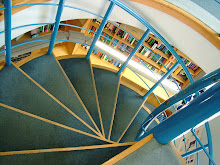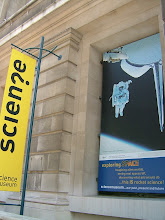Quantum spin probe able to measure spin states at individual atoms; could have application in quantum computing 20 June 2001
By Robert Sanders, Media Relations
Image of the electron cloud around a nickle impurity in a high-temperature superconductor, obtained with a scanning tunneling microscope. The central spot is the nickle atom, surrounded by a cloverleaf pattern whose fourfold symmetry is indicative of the underlying d-wave nature of the high-temperature superconducting state.PHOTO CREDIT: Seamus Davis/UC BerkeleyBerkeley - University of California, Berkeley, scientists probing the quantum weirdness of high-temperature superconductors have built a scanning tunneling microscope that can measure for the first time the quantum spin of an electronic state of a single atom, in this case an impurity atom embedded in the superconductor.
Until now, scientists have had to trap isolated atoms and zap them with a laser to measure their spin state.
The technique already has improved understanding of high temperature superconductors, which, 15 years after their discovery, are still an enigma. It also can help probe the spin states of atoms in metals and semiconductors, as well as in new materials such as carbon nanotubes or strontium ruthenate superconductors.
The researchers, however, are most excited about its potential application in quantum computers.
The results are reported in the June 21 issue of Nature by J. C. S嶧mus Davis, professor of physics at UC Berkeley and a researcher in the Materials Sciences Division of Lawrence Berkeley National Laboratory, and his collaborators at Boston University, Tokyo University and the National Institute of Standards and Technology (NIST).
In atoms or nuclei, spin is analogous to counterclockwise rotation, like a top, and the energy of a state depends on whether the spin axis points up or down. Spin interactions can have important consequences - the pairing of two electrons of opposite spin, a Cooper pair, in a low-temperature superconductor is the source of its zero electrical resistance and other unique properties.
A two-state system - spin up or spin down - is also what scientists look for in the "qubit" of a quantum computer. The two spin states are analogous to the ones and zeros of the binary alphabet used by today's computers, from palm pilots to Cray supercomputers.
Scientists predict that quantum computers taking advantage of two-level quantum states like this will be able to perform calculations far faster than conventional transistor-based computers, and in the process shrink the size of computers immensely.
"One of the holy grails of solid state physics is to write and store information in just one atom," Davis said. "We now have the ability to separate the spin-up state from the spin-down state at a single atom. This could lead to new tools for using spins for quantum computing."
"This is a fantastic new atomic-scale quantum probe of atoms in the solid state," said theoretical chemist K. Birgitta Whaley, professor of chemistry at UC Berkeley. Whaley is leading an effort to create a new center at UC Berkeley to study quantum computing, and Davis is part of the team.
His co-authors on the Nature paper are former UC Berkeley postdoctoral associate Eric W. Hudson, PhD, now a National Research Council Fellow at NIST in Gaithersburg, Md.; Shuheng Pan, a professor at Boston University; Shin-ichi Uchida, professor, and Hiroshi Eisaki, PhD, of the University of Tokyo's Department of Superconductivity; and graduate student Kristine M. Lang and postdoctoral associate Vidya Madhavan of UC Berkeley. Eisaki currently is on sabbatical at Stanford University.
In a quantum computer, each one or zero is called a qubit or quantum bit, and various systems have been proposed to represent these qubits. They range from the up and down spins of atomic nuclei manipulated with a nuclear magnetic resonance machine, to ions trapped in a cryogenic vacuum chamber, their states flipped with pulses of radio waves.
The disadvantage of these systems is that the devices used to read or write the qubits are large and cumbersome and not scalable to large numbers of qubits, Davis said.
Scanning tunneling microscopes (STM), however, were designed to probe materials on an atomic scale by way of a microscopic tip that hovers over the surface and maps the intensity of the electron clouds. Qubits stored as closely packed impurity atoms in a solid crystal could be read out by an STM much like a recording head reads and writes magnetic bits on a CD. Davis notes that the scanning tunneling microscope should work just as well at measuring spin states around impurities in semiconductors and metals.
"Bruce Kane of the University of Maryland has proposed using phosphorus atom impurities in a silicon semiconductor as qubits of a quantum computer," Whaley said. "The problem has been, how do you manipulate the spins of single atoms? This is a great way to do that."
Davis's group discovered the power of their STM while studying the effect of single-atom impurities in pure samples of a copper oxide high-temperature superconductor (Bi2Sr2CaCu2O8+d) - dubbed BSCCO (BIS-ko) because it is composed of bismuth, strontium, calcium, copper and oxygen. The researchers' goal is to find out why these composite materials are superconductors at relatively high temperatures - 85 degrees above absolute zero (-307蚌) instead of 4 degrees above zero (-452蚌) typical of low-temperature superconductors - and perhaps find a recipe for making better ones.
Superconductors carry electricity without energy loss, and thus are attractive components of electrical transmission lines, motors or high-powered magnets.
Last year the UC Berkeley group used its STM to make the first images of electron clouds around a zinc atom impurity in a BSCCO superconductor. The researchers next placed a magnetic atom, nickel, into the regular crystal structure of the superconductor to see what more it would reveal about the unknown quantum processes at work in high-temperature superconductors. Because the superconductivity of high-temperature superconductors is thought to involve interactions among the magnetic moments of the individual atoms, theoreticians have predicted that nickel should disrupt the superconductivity less than a non-magnetic atom such as zinc.
In mapping the electron clouds with the STM, they found, in fact, that nickel left the superconductivity undamaged, in contrast to the nearby disruption caused by zinc. Because of this, the scientists were able to observe quantum phenomena around the nickel impurity that they did not see with zinc.
In high-temperature superconductors, many electrons fly about as unpaired quasiparticles - basically broken Cooper pairs, which are the form in which electrons travel in conventional low-temperature superconductors. These quasiparticles scatter off an impurity and form a small electron cloud that hovers around the impurity like a cloud around a mountain peak.
Around a zinc impurity, Davis and his team saw a simple quasiparticle cloud. Around nickel, however, they saw structure in the cloud created by the magnetic moment of the nickel atom. It was as if two different kinds of clouds could hug the impurity, one - a spin-up electron cloud - at a higher energy than the other, spin-down electron cloud. They could tell the difference by its effect on the electrical current flowing through the STM tip.
They observed another quantum phenomenon, too. Because of the ambiguities of quantum mechanics, quasiparticles in a superconductor are actually a 50/50 mixture of particle and non-particle, which is called a hole. The scientists verified this with the STM, detecting both particles and holes around the nickel impurity.
The presence of holes as well as particles proves that nickel does not impair the superconductivity, and it strongly supports the theory that high-temperature superconductors work through magnetic interactions among the atoms.
Theoretician Alexander V. Balatsky of Los Alamos National Laboratory, who predicted the spin splitting by a magnetic atom impurity, was amazed at how closely the experiment fit his predictions, which initially were met with skepticism.
"Our prediction was made long before the experimental capability to tunnel into a very clean system with very few impurities existed," he said. "It shows that some aspects of our theory work and gives us confidence that we have predictive power for these enigmatic materials."
From: http://berkeley.edu/news/media/releases/2001/06/20_physc.html
訂閱:
張貼留言 (Atom)









沒有留言:
張貼留言